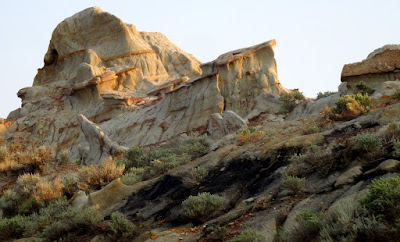We headed back into the park a little earlier today to see what we missed in the dark yesterday. We found the colorful exposed layers to be especially photogenic and hopefully we were able to capture some of the beauty that makes Theodore Roosevelt National Park so special.
Geology absolutely intrigues me. This park has hijacked my research interest that resulted in finding a blog written by John Bluemle, PhD called North Dakota Geology. (The excerpts and information that follow, along with links to pertinent pages, are from his blog.)
"General Alfred Sully, preparing to cross the badlands in August of 1864, described them as “hell with the fires burned out.” Theodore Roosevelt, who lived for a while in the Little Missouri Badlands in the 1880s, described them as “fantastically beautiful.”"
Concretion pedestals known as “hoodoos,” mushroom-like shapes perched on stalks of clay, are seen throughout the park.
The last of the Ice Age glaciation events is the most important to North Dakota. This event occurred between 25,000 and 12,000 years ago.
Ice sheets, perhaps 400 feet thick (and as much as a mile thick in the northeast corner), covered about three-fourths of the state. The ice sheets extended as far south as the Missouri River.
This corner of North Dakota was not under glaciers but was heavily influenced by them. The glaciers changed the direction of the Little Missouri River and that started the erosion process that carved Roosevelt's topography.
“Late in the Cretaceous, beginning about 70 million years ago, and continuing through the Paleocene, until about 56 million years ago, western North Dakota’s climate was subtropical. Trees up to 12 feet in diameter and more than 100 feet tall grew in a setting similar to today’s Dismal Swamp in Virginia, or the Florida Everglades, with meandering rivers, swamps, and vast forested floodplains.”
"...in the South Unit of Theodore Roosevelt National Park, a lignite seam burned from 1951 until 1977." (Lignite is a layer of "soft" coal.)
The hoodoos below were one of my favorite subjects with the sun just peeking over the hill spotlighting the tops of the structures.
There were a few wild horses in view but not really close enough for anything but an extreme telephoto shot.
We had just enough time before sunset to drive to the Painted Canyon Overlook. The overlook Visitor's Center and parking area were shared with a rest area along I-94 at exit 32. That had to make this one of the most spectacular Interstate Rest Areas in the system. Unfortunately, there was no cloud drama for a really nice sunset and the air was very hazy with smoke from some far off fire (in Idaho, I think), so we just watched as the sun slowly sank below the horizon.






















No comments:
Post a Comment